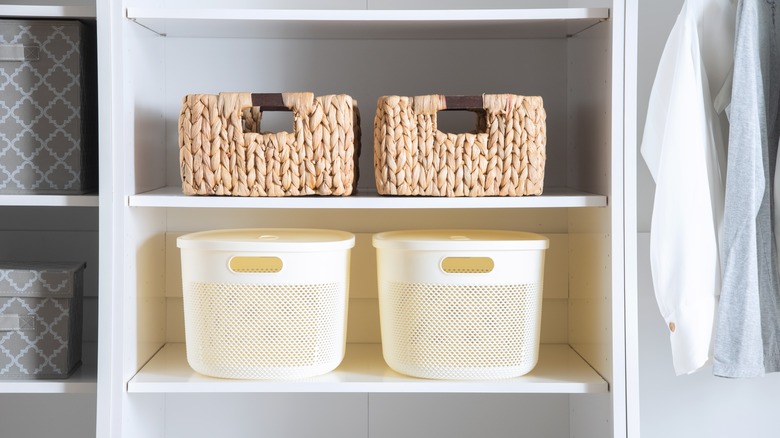Master Seasonal Closet Swapping While Preventing Clutter
We may receive a commission on purchases made from links.
Swapping out your clothes and shoes seasonally is a good way of keeping your wardrobe ready for the coming months and reducing decision paralysis. But you must plan it well, or you'll inadvertently give way to clutter. For instance, not planning out how and where you'll store the clothes you're retiring will lead to chaos and make your closet look more disorganized than when you started. So, to master seasonal closet swapping, determine where you'll house your seasonal items. Do you have some vertical space to spare above your closet? Or, will you have to try out a few smart tension rod hacks for closet storage and organization? Maybe you'll have to resort to stashing them away in your guest room, under your bed, or attic.
Once you have the location(s) squared away, collect the bins, baskets, and bags you'll need to house your off-season garments. While most everyday clothes will fare well in either storage solution, you'll need specific elements for certain items. For example, you can't just fold and tuck away your cashmere, wool, or silk sweaters and dresses in a plastic bin and expect them to come out of storage looking fab. You need linen ones, like Fordonral's 4 Pack Storage Containers, so they can breathe properly. Moreover, you'll need garment bags for your chunky coats, so they retain their shape well. Cotton pieces fare well in airtight baskets and can be vacuum-sealed, too, if you're dealing with limited space. Your leather jackets and pants will thank you if you stuff their pockets and sleeves with non-acidic paper, such as Rykomo's Unbuffered Wrapping Sheets.
Tips to help you master seasonal closet swapping
A common mistake everyone makes when organizing their closet is not decluttering their seasonal collection. To illustrate, if you're retiring your spring and summer pieces to make room for wintery ones, editing your frilly dresses, shorts, skirts, and thin shirts will help you pinpoint pieces you don't wear anymore. This way, you can donate or sell them without having to worry about cleaning or making room for them in your small dressing space. So, always go through all the items you're considering packing away for the next season. Additionally, follow this approach for items you're bringing out of storage to minimize clutter. Want to be prepared for the next swap in advance? Try the reverse hanger trick, an old-school decluttering hack that will actually organize your closet.
After you have the clothes and shoes you're sure you'll wear next season, sort them by category, like shirts, pants, dresses, shoes, accessories, to make storage easier. Put your heavy or well-worn pieces toward the bottom and place your new-ish or lighter items on top. Now, start organizing the pieces you're taking out of storage. Think of the garments you'll require on a daily basis and give them the prime spots to make it easier for you to get ready in the mornings. If you work from home in your dragon pajamas, ensure your loungewear is at eye level. But if you have to go to the office, organize your formals toward the front of your closet. Put your occasional wear or just-because items near the back or on lower shelves. The same goes for your footwear. Prioritize sandals, breathable sneakers, and open-toed boots during summer and vice versa in winter.
Things not to do when swapping out your seasonal closet
Since swapping out your clothes, footwear, and accessories twice a year can be a daunting task, give yourself some grace and don't rush the process. In case you're tired after you sort your garments and need a break, call it a day and put them aside. You can always organize them the next day. But don't put off the task indefinitely, or your closet will never look neat and tidy. Moreover, never store dirty items. Otherwise, the stains will set in permanently, and you'll have a hard time getting rid of them. Pests, like moths, might also take an interest in the spots and chew through your favorite sweaters and shirts.
To keep your stored garments safe from moths, drop in a few cedar blocks, such as Houndsbay's. Alternatively, use Oruwvwuro's Lavender Sachets to prevent cloth-eating insects from munching on your clothes and ensure the stored pieces don't smell bad. Another thing you don't want to do is store bins and baskets without labeling them. While transparent ones won't give you much headache, opaque or fabric ones will make it difficult to find things when you need them. So, don't forget to label your containers when storing items. Purchase chalkboard ones to keep reusing your labels, or print fancy ones from your nifty label maker. Also, always invest in matching bin and basket sets to minimize visual clutter. That being said, it's generally okay to mix two or three styles together, provided they gel well with each other.


